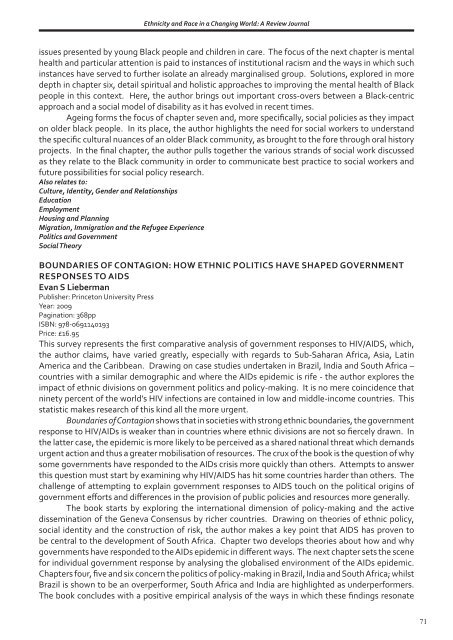Ethnicity and Race in a Changing World
Volume 2, Issue 1, 2010 - Manchester University Press
Volume 2, Issue 1, 2010 - Manchester University Press
- No tags were found...
You also want an ePaper? Increase the reach of your titles
YUMPU automatically turns print PDFs into web optimized ePapers that Google loves.
<strong>Ethnicity</strong> <strong>and</strong> <strong>Race</strong> <strong>in</strong> a Chang<strong>in</strong>g <strong>World</strong>: A Review Journalissues presented by young Black people <strong>and</strong> children <strong>in</strong> care. The focus of the next chapter is mentalhealth <strong>and</strong> particular attention is paid to <strong>in</strong>stances of <strong>in</strong>stitutional racism <strong>and</strong> the ways <strong>in</strong> which such<strong>in</strong>stances have served to further isolate an already marg<strong>in</strong>alised group. Solutions, explored <strong>in</strong> moredepth <strong>in</strong> chapter six, detail spiritual <strong>and</strong> holistic approaches to improv<strong>in</strong>g the mental health of Blackpeople <strong>in</strong> this context. Here, the author br<strong>in</strong>gs out important cross-overs between a Black-centricapproach <strong>and</strong> a social model of disability as it has evolved <strong>in</strong> recent times.Age<strong>in</strong>g forms the focus of chapter seven <strong>and</strong>, more specifically, social policies as they impacton older black people. In its place, the author highlights the need for social workers to underst<strong>and</strong>the specific cultural nuances of an older Black community, as brought to the fore through oral historyprojects. In the f<strong>in</strong>al chapter, the author pulls together the various str<strong>and</strong>s of social work discussedas they relate to the Black community <strong>in</strong> order to communicate best practice to social workers <strong>and</strong>future possibilities for social policy research.Also relates to:Culture, Identity, Gender <strong>and</strong> RelationshipsEducationEmploymentHous<strong>in</strong>g <strong>and</strong> Plann<strong>in</strong>gMigration, Immigration <strong>and</strong> the Refugee ExperiencePolitics <strong>and</strong> GovernmentSocial TheoryBOUNDARIES OF CONTAGION: HOW ETHNIC POLITICS HAVE SHAPED GOVERNMENTRESPONSES TO AIDSEvan S LiebermanPublisher: Pr<strong>in</strong>ceton University PressYear: 2009Pag<strong>in</strong>ation: 368ppISBN: 978-0691140193Price: £16.95This survey represents the first comparative analysis of government responses to HIV/AIDS, which,the author claims, have varied greatly, especially with regards to Sub-Saharan Africa, Asia, Lat<strong>in</strong>America <strong>and</strong> the Caribbean. Draw<strong>in</strong>g on case studies undertaken <strong>in</strong> Brazil, India <strong>and</strong> South Africa –countries with a similar demographic <strong>and</strong> where the AIDs epidemic is rife - the author explores theimpact of ethnic divisions on government politics <strong>and</strong> policy-mak<strong>in</strong>g. It is no mere co<strong>in</strong>cidence thatn<strong>in</strong>ety percent of the world’s HIV <strong>in</strong>fections are conta<strong>in</strong>ed <strong>in</strong> low <strong>and</strong> middle-<strong>in</strong>come countries. Thisstatistic makes research of this k<strong>in</strong>d all the more urgent.Boundaries of Contagion shows that <strong>in</strong> societies with strong ethnic boundaries, the governmentresponse to HIV/AIDs is weaker than <strong>in</strong> countries where ethnic divisions are not so fiercely drawn. Inthe latter case, the epidemic is more likely to be perceived as a shared national threat which dem<strong>and</strong>surgent action <strong>and</strong> thus a greater mobilisation of resources. The crux of the book is the question of whysome governments have responded to the AIDs crisis more quickly than others. Attempts to answerthis question must start by exam<strong>in</strong><strong>in</strong>g why HIV/AIDS has hit some countries harder than others. Thechallenge of attempt<strong>in</strong>g to expla<strong>in</strong> government responses to AIDS touch on the political orig<strong>in</strong>s ofgovernment efforts <strong>and</strong> differences <strong>in</strong> the provision of public policies <strong>and</strong> resources more generally.The book starts by explor<strong>in</strong>g the <strong>in</strong>ternational dimension of policy-mak<strong>in</strong>g <strong>and</strong> the activedissem<strong>in</strong>ation of the Geneva Consensus by richer countries. Draw<strong>in</strong>g on theories of ethnic policy,social identity <strong>and</strong> the construction of risk, the author makes a key po<strong>in</strong>t that AIDS has proven tobe central to the development of South Africa. Chapter two develops theories about how <strong>and</strong> whygovernments have responded to the AIDs epidemic <strong>in</strong> different ways. The next chapter sets the scenefor <strong>in</strong>dividual government response by analys<strong>in</strong>g the globalised environment of the AIDs epidemic.Chapters four, five <strong>and</strong> six concern the politics of policy-mak<strong>in</strong>g <strong>in</strong> Brazil, India <strong>and</strong> South Africa; whilstBrazil is shown to be an overperformer, South Africa <strong>and</strong> India are highlighted as underperformers.The book concludes with a positive empirical analysis of the ways <strong>in</strong> which these f<strong>in</strong>d<strong>in</strong>gs resonate71






